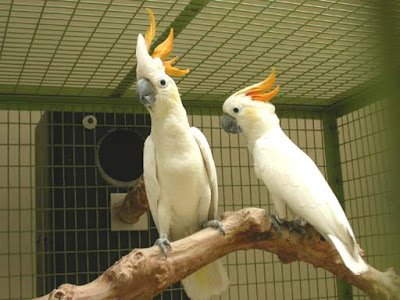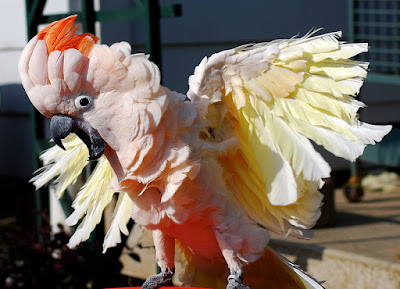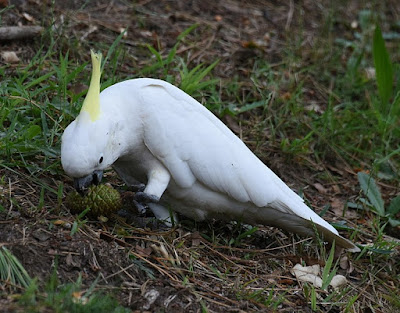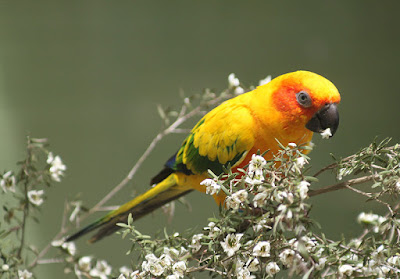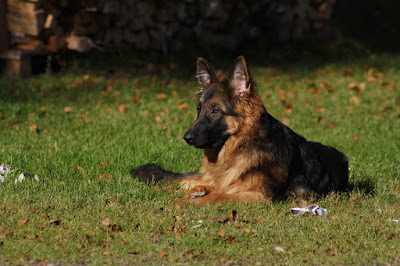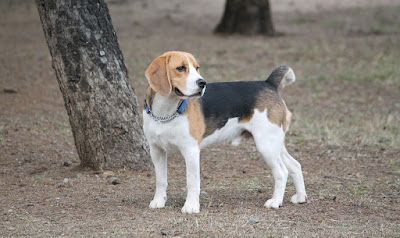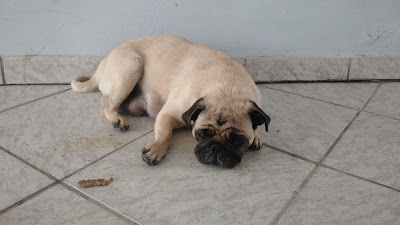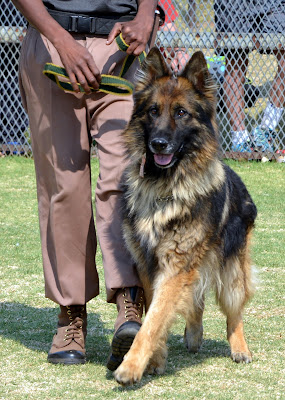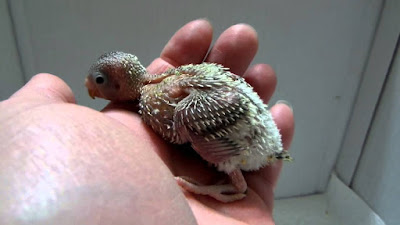 |
| Scarlet Macaw |
1 Scarlet Macaw
Scarlet macaws are enormous, wonderful and bright parrots with red, yellow, and blue plumes. The body of the Scarlet macaw from mouth to tail can be up to 33 inches. This kind of macaw has solid snout is adjusted to breaking hard nuts found in the rain forest. The red macaw can be found from southern Mexico to Peru, just as Bolivia, eastern Brazil and the island of Trinidad. A hostage red macaw can live for a long time or more, however 40 to 50 years is progressively run of the mill. Red macaws are incredibly wise winged animals.The best diet for a macaw begins with a good parrot mix that includes formulated foods, a variety of seeds, dried fruits, and nuts. To this base diet, provide plenty of fresh fruits and vegetables on a daily basis.
 |
| African Grey Parrot |
African Gray Parrot is one of clever and excellent parrot species. They are fit for storing up vocabularies of up to 1000 words or more. there are two sorts of dim parrot, initial one is Timneh Gray Parrot and second one is Congo Gray Parrot.
The most prominent and regular is the Congo African Gray. The Congo African Gray is the biggest of the African Gray parrots, brandishing a lighter dim shading in its plumage, and a strong dark nose. The African grey parrot is a standout amongst the most capable talking/imitating winged creatures on the planet. African dark parrots for the most part occupy savannas, seaside mangroves, forest and edges of woodland clearings in their West and Central Africa extend. African dark parrot can live for 30 to 35 years. Normal Weight: 330-500 gm. Wild African grey parrots feed on an assortment of natural products, nuts, and vegetables.
The most prominent and regular is the Congo African Gray. The Congo African Gray is the biggest of the African Gray parrots, brandishing a lighter dim shading in its plumage, and a strong dark nose. The African grey parrot is a standout amongst the most capable talking/imitating winged creatures on the planet. African dark parrots for the most part occupy savannas, seaside mangroves, forest and edges of woodland clearings in their West and Central Africa extend. African dark parrot can live for 30 to 35 years. Normal Weight: 330-500 gm. Wild African grey parrots feed on an assortment of natural products, nuts, and vegetables.
 |
| Amazon Parrot |
3 Amazon Parrot
Amazon parrots are among the more prominent medium-sized parrot species. Amazon parrots are from Mexico, South America, just as parts of the Caribbean. The wild Amazon's regular propensities incorporate savannas, palm forests, scour backwoods and rainforest. As their name shows, their local living space is in the Amazon district of South America. A few animal types, for example, the Amazonas. Amazons are commonly stocky parrots with essentially green hue and short, rather adjusted tails. Most species should be DNA tried to decide sexual orientation. Their sizes extend from the White-fronted at 10 inches (25.4 cm) and 188-242 gm to the Mealy Amazon which estimates 15 inches (38.5 cm) and weighs around 708 gm. Amazons can copy the sound of their proprietor's voice and are viewed as generally excellent talkers. They can likewise be very boisterous, and can regularly represent an issue whenever kept in condo structures. they achieve sexual development at around 4 to 5 years old. Amazons species life expectancies go from 30 to 60 years in bondage. Some mainstream types of Amazon parrots are
Blue Fronted Amazon ParrotOrange Winged Amazon Parrot PriceRed Lored Amazon Parrot PriceYellow Naped Amazon Parrot PriceDouble Yellow Headed Amazon Parrot
4 Cockatoo
Cockatoos emerge from other parrot species with their emotional peak quills, dusty plumes, and shifting shades of white, pink, dim and dark. There are 21 types of cockatoos, The different cockatoo species have local ranges in Australia, Australasia, Indonesia, the Solomon Islands and New Guinea. Cockatoos vary from different parrots not just in view of their peak, since they are for the most part dark or white. Cockatoo is extremely an appealing and astute flying creature. Normal size rangeis 14 to 30 inches and weight 350 to 980 gm.
Some well known types of Cockatoo are
Some well known types of Cockatoo are
1 Bare-Eyed Cockatoos
2 Black Palm Cockatoos
3 Citron Cockatoos
4 Goffin's Cockatoos
5 Major Mitchell's
Cockatoos
6 Moluccan Cockatoos
7 Rose Breasted
Cockatoos
8 Slender-Billed
Cockatoos
9 Sulphur Crested
Cockatoos
10 Umbrella Cockatoos
5 Eclectus parrots
Eclectus parrots arrive in an assortment of sub-animal varieties, including the Grand Eclectus, the Vosmaeri, and the Solomon Island (Eclectus roratus solomonensis) which is the most ordinarily found Eclectus in bondage. Beginning in the Solomon Islands. The Eclectus Parrot is a huge parrot (430-450mm including tail) with checked sexual dimorphism (the male and female are extraordinary).
The male is emerald green, with curve of wing blue, primaries dark blue, underwing coverts and sides of paunch rich red, has a short square tail with focal tail plumes green tipped with blue;outer tail quills are blue tipped with white; underside of the tail is gloomy tipped yellow. The eye is orange.
The upper mandible of its bill is coral pink, yet the lower mandible is dark. Feet and toes are mid dim. The female has distinctive red plumage, darker and more blunt on back and wings.
has a hands on over the mantle and the twist of the wing and underwing coverts are splendid blue, with a wide violet-blue band over the paunch, tail is red tipped with orange, around the light yellow eye is a blue ring. The feet and toes are equivalent to for the male.In trip for both genders the blue-wing linings and orange tail are prominent. The Eclectus Parrot feeds in trees on berries and other fruit, nuts, seeds and blossoms.. The normal grown-up male Eclectus is 430 grams and the grown-up female Eclectus is 452 grams.
The male is emerald green, with curve of wing blue, primaries dark blue, underwing coverts and sides of paunch rich red, has a short square tail with focal tail plumes green tipped with blue;outer tail quills are blue tipped with white; underside of the tail is gloomy tipped yellow. The eye is orange.
The upper mandible of its bill is coral pink, yet the lower mandible is dark. Feet and toes are mid dim. The female has distinctive red plumage, darker and more blunt on back and wings.
has a hands on over the mantle and the twist of the wing and underwing coverts are splendid blue, with a wide violet-blue band over the paunch, tail is red tipped with orange, around the light yellow eye is a blue ring. The feet and toes are equivalent to for the male.In trip for both genders the blue-wing linings and orange tail are prominent. The Eclectus Parrot feeds in trees on berries and other fruit, nuts, seeds and blossoms.. The normal grown-up male Eclectus is 430 grams and the grown-up female Eclectus is 452 grams.
6 Sun Conure
The sun conure is one of the more notable conures of its size in view of its amazing plumage, its sensational way, and its great quality as an amigo winged creature. The sun conure is around 12 crawls long, and is most undeniable by its splendid orange and yellow concealing, normally mottled done with splotches of green. The sun conure has a dim nose, white rings around its eyes, and a long, diminishing tail. these winged creatures are incredibly loud, and are not a good choice for the people who live in lofts. these feathered animals can have a future of up to 30 years in subjugation.
7 Cockatiels
Cockatiels are close to nothing, crested people from the parrot family. They are known for their smooth nature. Dim is the most broadly perceived concealing, yet they are furthermore available in pearl, white-faced, white faced pearl, lutino, pied and additionally concealing assortments. Ordinary adult size is 11 to 14 creeps long, head to complete of tail and Weight: 80-120 gm. Typical future is up to 25 years with proper thought. For the most part serene flying animal. Favored known for whistling limit over for talking.
8 Rosella
Rosella is an amazingly toned, extensive pursued parakeet neighborhood to Australia. Rosellas stretch out in size from 25-38 cm (9.8-15 in) and adults are usually outstandingly clear. Energetic winged animals are consistently increasingly obtuse, and accomplish the adult tint after their subsequent shed - when they are around 12 to 16 months old. Around then they also become unequivocally full developed. In their standard living space, they for the most part feed on grass and tree seeds (checking developed seeds that dropped to the floor and were introduced to stickiness), similarly as a variety of natural items, berries, blooms and nectar.Additionally, they take frightening little animals in their hatchlings - particularly during the imitating season, when they require more protein in their eating schedule. Australia is home to various sorts of enthusiastically tinted rosella, including Crimson Rosellas, Eastern Rosellas, Western Rosellas, Northern Rosellas, Pale-headed Rosellas, Yellow Rosellas, Adelaide Rosellas and Green Rosellas. Raising is among October and January. They as a rule settle in pits in trees or dead tree plant trunks, laying 4–6 white eggs which the female seals for 22–24 days. The chicks fledge at around 30 days and remain with their people for some time.
9 Ringneck parrot
The Indian ringneck parakeet is a sub-kinds of the rose-ringed parakeet and the many sub-species are dispersed all through Africa and Asia. The Indian ringneck is an Asiatic parrot and at first from Ceylon anyway it's as of now found in various bits of Asia, amazingly India and Pakistan. They can similarly be found in western and southern zones of Sudan and are noticeable in the Middle East where they are raised and found in nature. Parrot with body 37-43cm long (tallying tail), weight 95-143gm. They are typically green. Guys have dim and climbed toned neck area on neck, females and youths have no collar.beak has red upper and dull lower mandible. Tail is long. Future up to 34 years in detainment. They generally feed Various grains, characteristic item, nuts, vegetables, blooms.
10 Budgerigar
Budgerigar is one of little and splendid parakeet species. Budgerigars are around seven and a half inches long, and measure 30-40gm, and come in numerous wonderful shades of greens and yellows. Generally, this parakeet are found in warm regions. They will all in all have a shorter future than some other parrot species, generally living some place in the scope of 6 and 12 years. They feed just on grass seeds particularly of tussock - grasses, less consistently seeds of herbaceous plants. The female incubates the eggs for 18 days in the exhausted out trunk or tree limb, young leave the home after 30 days.
For more exotic pets updates please click here


